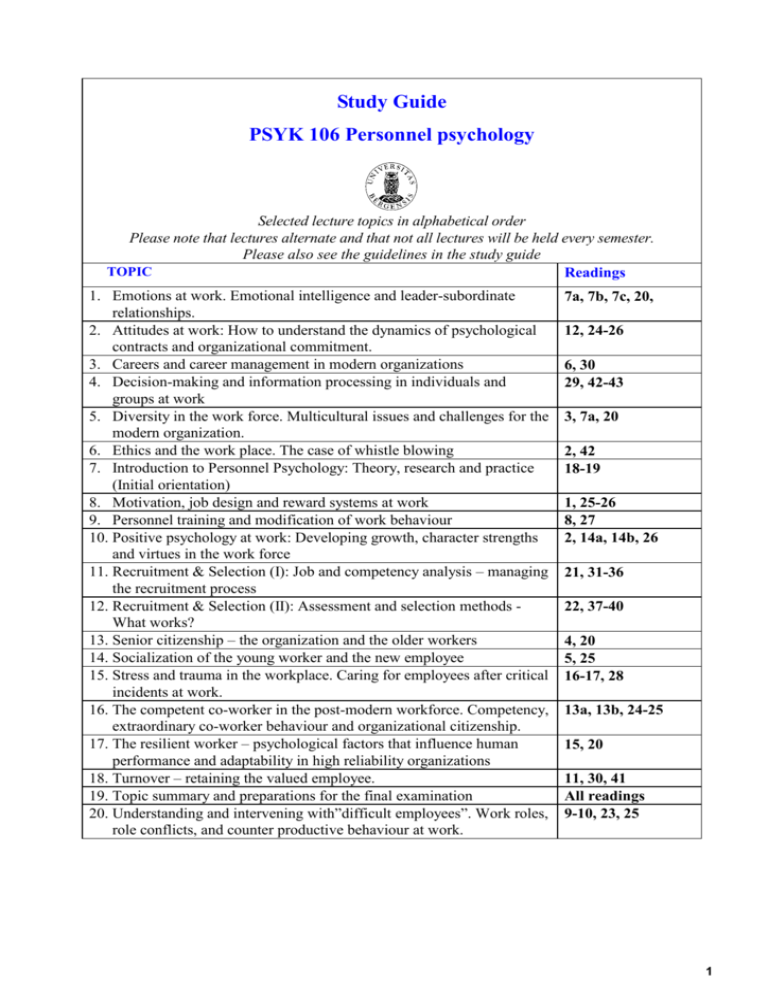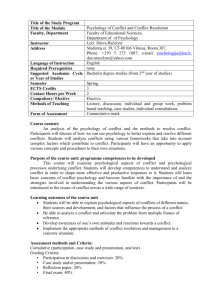
Study Guide
PSYK 106 Personnel psychology
Selected lecture topics in alphabetical order
Please note that lectures alternate and that not all lectures will be held every semester.
Please also see the guidelines in the study guide
TOPIC
Readings
1. Emotions at work. Emotional intelligence and leader-subordinate
relationships.
2. Attitudes at work: How to understand the dynamics of psychological
contracts and organizational commitment.
3. Careers and career management in modern organizations
4. Decision-making and information processing in individuals and
groups at work
5. Diversity in the work force. Multicultural issues and challenges for the
modern organization.
6. Ethics and the work place. The case of whistle blowing
7. Introduction to Personnel Psychology: Theory, research and practice
(Initial orientation)
8. Motivation, job design and reward systems at work
9. Personnel training and modification of work behaviour
10. Positive psychology at work: Developing growth, character strengths
and virtues in the work force
11. Recruitment & Selection (I): Job and competency analysis – managing
the recruitment process
12. Recruitment & Selection (II): Assessment and selection methods What works?
13. Senior citizenship – the organization and the older workers
14. Socialization of the young worker and the new employee
15. Stress and trauma in the workplace. Caring for employees after critical
incidents at work.
16. The competent co-worker in the post-modern workforce. Competency,
extraordinary co-worker behaviour and organizational citizenship.
17. The resilient worker – psychological factors that influence human
performance and adaptability in high reliability organizations
18. Turnover – retaining the valued employee.
19. Topic summary and preparations for the final examination
20. Understanding and intervening with”difficult employees”. Work roles,
role conflicts, and counter productive behaviour at work.
7a, 7b, 7c, 20,
12, 24-26
6, 30
29, 42-43
3, 7a, 20
2, 42
18-19
1, 25-26
8, 27
2, 14a, 14b, 26
21, 31-36
22, 37-40
4, 20
5, 25
16-17, 28
13a, 13b, 24-25
15, 20
11, 30, 41
All readings
9-10, 23, 25
1
Study Guide: Recommended readings
PSYK 106 Personnel Psychology
COMPENDIUM
Topics in Personnel Psychology
Incentive plans and motivation
Kohn, A. (1996). Why Incentive Plans Cannot Work. (512-518). In R. M.
Steers, L. W. Porter & Bigley, G. A, red. Motivation and leadership at work. New
York: McGraw-Hill. (6p.)
Number
in study
guide
1
Ethics, whistle blowing & diversity at work
Newell. S. (2002). Creating the healthy organization. Well being, diversity &
ethics at work. London; Thompson. (kap. 8-9, 191 - 222). (30p.)
Wayne F. Cascio & Herman Aguinis (2005). Applied psychology in human
resource management, 6. utg. New Jersey: Pearson/Prentice Hall. Kap. 17:
International dimensions of applied psychology (435-454) (20p.)
2
3
Diversity, individual differences and socialization at work
Duglas T. Hall (2002). Careers in and out of organizations. Kap 1 The study of
careers (pp.8-16) and Kap 2 The protean career contract (pp.17- 46). London:
Sage Publications. (35p.)
Feij, J. A.(1998). Work socialisation of young people. I P. J. D. Drenth, H.
Thierry, & C. J deWolff, Handbook of Work and Organisational Psychology:
Personnel Psychology, ( pp.207-249). East Sussex: Psychology Press. (42p.)
Brooklyn Derr, C. & Laurent, A. 'The internal and external career: a
theoretical and cross-cultural perspective' i M. B. Arthur, D. T. Hall & B.S.
Lawrence (eds.) (1996). Handbook of Career Theory. (454-471). Melbourne:
Cambridge University press. (18p.)
Furnham, A. (2001). Personality and Individual Differences in the
Workplace. In B. W. Roberts & R. Hogan (pp. 223-251). Personality Psychology
in the Workplace. Washington: American Psychological Association. (28p.)
Glasø, L., Ekerholt, K., Barman, S., & Einarsen, S. (2006). The instrumentality
of emotion in leader-subordinate relationships. International Journal of Work
Organisation and Emotion,1(3), 255-275. (22p.)
Glasø, L., & Einarsen, S. (2006). Experienced affects in leader-subordinate
relationships. Scandinavian Journal of Management, 22, 49-73.(24p)
4
5
6
7a
7b
7c
Training and Development
Milward, L. (2005). Training (pp.75 – 130). In L. Milward Understanding
Occupational & Organizationap Psychology. Sage – London. (55p.)
8
Work roles and difficult employees
Furnham, A. & Taylor J. (2004). The dark side of behaviour at work.
Understanding and avoiding employees leaving, thieving and deceiving. Kap.
4: Counterproductive behaviours at work and 5 Bad person theories.
Strassberg, Z. (2001). Understanding, assessing, and intervening with
problem employees. In M. London (ed). How People Evaluate Others in
9
10
2
Organizations (pp. 253- 277). London: Lawrence Earlbaum Associates. (25p.)
Turnover, commitment, and retaining valued employees
Griffeth, R. W. & Hom, P. W. (2001). Retaining Valued Employees.. Kap 1, 1 30 og Kap. 8, 180 - 202. (50p.)
Meyer, J.P. & Allen, N.J. (1997): Commitment in the Workplace. Theory,
Research and Application. Thousand Oaks: SAGE Publications. Kapittel 2:
Meaning Commitment (s. 8-22) & kapittel 4: Development of Organizational
Commitment (41-65). (36p.)
Walter C. Borman & Louis A. Penner (2001). Citizenship Performance. Its
nature, Antecedents, and Motives
Kurz, R. & Bartram, D. (2002). Kap.10 Competency and individual
performance: Modelling the world of work. I Robertson, Callinan & Bartram
Organizational effectiveness (pp. 227- 255).
11
12
13a
13b
Positive psychology at work: Developing growth, character
strengths and virtues in the work force
Seligman, E. P. et al. (2005). Positive Psychology Progress: Empirical
validation of interventions (pp.874-884) and,
Jørgensen, I. S. & Nafstad, H. E. (2005) Positive Psychology: Historical,
philosophical, and epistemological perspectives (pp. 885- 896). Tidsskrift for
Norsk Psykologforening vol 42. (23p.)
14a
14b
The resilient worker – psychological aspects related to working in
high risk and high performance organizations
Flin, R. (2001). Selecting the right stuff: Personality and high-reliability
occupations. In R. W. Roberts & R. Hogan Personality psychology in the
workplace (pp. 253-275). American Psychological Association.
15
Stress and trauma in the workplace. Caring for employees after
critical incidents at work.
Mitchell, J. T. & Everly, G. (2000). Critical Incident Stress Management and
Critical Incident Stress Debriefings: evolutions, effects and outcomes (pp.7190). In B. Raphael & J. P. Wilson (eds) Psychological Debriefing: Theory,
practice and evidence. Cambridge University Press. (19p.).
Briere, J. (2004). Psychological Assessment of Adult Posttraumatic States (pp.
5-37). APA – Washington DC. (32p.).
16
17
3
Number in
study guide
Arnold, J., Silvester, J., Patterson, F., Cooper, C. & Burnes, B.
(2005). ”Work Psychology”. Chapter 1-12 and 14 (500 p.).
Ch.1
Ch 2
Ch 3
Ch 4
Ch 5
Ch 6
Ch 7
Ch 8
Ch 9
Ch 10
Ch 11
Ch 12
Ch 14
Work Psychology: An initial orientation
Theory, research and practice in work psychology
Individual differences
The foundations of personnel selection: analysing jobs, competencies
and selection effectiveness
Personnel selection and assessment methods: what works?
Assessing people at work
Attitudes at work
The analysis and modification of work behaviour
Approaches to work motivation and job design
Training
Stress in the Workplace
Decisions, groups and teams at work
Careers and career management
18
19
20
21
22
23
24
25
26
27
28
29
30
Dominic Cooper, Ivan T. Robertson & Gordon Tinline (Eds 2003). Recruitment
and selection: A framework for success. (Thomson Publishing. 200 p.)
Ch 01
Ch 02
Ch 03
Ch 04
Ch 05
Ch 06
Ch 07
Ch 08
Ch 09
Ch 10
Ch 11
Ch 12
Ch 13
Personnel selection as part of a quality management
program
How people differ
Identifying customer needs and setting required
standards
Evaluative standards for selection methods
Establishing standards for selection procedures
Attracting candidates
Selection methods – interviewing
Selection methods – sample based
Selection methods – psychometrics
Selection methods – alternatives?
Candidate retention
Personnel selection decision-making standards
Continuous improvement
Number in study guide
31
32
33
34
35
36
37
38
39
40
41
42
43
4





